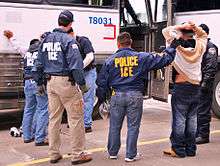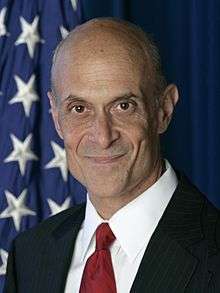Swift raids
The 2006 Swift raids were a coordinated effort by U.S. Immigration and Customs Enforcement (ICE) to detain and deport people who are undocumented.

On Tuesday, December 12, 2006, ICE raided six Swift & Company meatpacking plants in the midwestern United States. Workers were detained in central areas of these plants, where they were searched and interrogated. About 1,300 workers, accused of immigration violations and identity theft, were arrested and bused to detention facilities; most were deported.
ICE's "Operation Wagon Train", which culminated in the Swift raids, represented a new stage of immigration enforcement. The operation marked the beginning of increased workplace actions, as well as the special targeting of illegal immigrants who were also accused of crimes.[1][2][3] It was the largest workplace immigration raid in U.S. history.[4]
Background
Undocumented workers make up an estimated 5.1 percent of the US workforce.[5] At Swift & Co. meatpackers (purchased soon after the raids by JBS S.A.), those arrested during the raid were 10% of the company's workforce. Because only undocumented immigrants from the first shift were arrested, the actual proportion of undocumented workers may have been substantially higher.[6]
_badge_-_Special_Agent.jpg)
ICE, a branch of the Department of Homeland Security (DHS), investigated Swift for ten months prior to the raid. ICE subpoenaed Swift's employee records in March 2006.[2] It confirmed that some of Swift's employees had used Social Security information and birth certificates of others to illegally obtain employment.[7]
Swift apparently learned that they were under investigation, and was already making efforts to decrease their reliance on illegal workers.[6] The company shed about 400 illegal workers between March and December 2006.[2] However, upon request from the DHS, Swift did not inform its workers about the coming raids.[1]
On November 28, 2006, Swift requested an injunction against an ICE enforcement action, arguing that they were cooperating as best they could. On December 7, the injunction was denied by District Judge Mary Lou Robinson.[8] On December 8, ICE obtained a search warrant, which served as legal justification for the raid.[2][9] The basis of this warrant was 133 suspicious cases at Swift & Co.[10]
Raids
On December 12, federal agents raided Swift plants in Hyrum, Utah; Greeley, Colorado; Marshalltown, Iowa; Grand Island, Nebraska; Cactus, Texas; and Worthington, Minnesota. The action against Swift & Co. was known as "Operation Wagon Train" within the DHS. It was executed by over 1,000 ICE police, in some cases backed by local police with riot gear.[11] Thousands of workers—estimates range from 12,000[10] to 20,000[8] —were directly affected. Testimony suggests that events unfolded similarly at the six plants.[10]

Managers shut down assembly lines and instructed workers to report to central areas. Some resisted and were reportedly sprayed with chemical weapons.[11][12] Many were handcuffed. In some plants, workers were separated into two lines on the basis of their skin color; lighter-skinned workers were dismissed more quickly, while their darker-skinned counterparts were detained.[13]
Agents then interrogated them and decided which to arrest—a difficult process since many had not brought identification to work on that day. Language barriers also created confusion. ICE made use of Spanish translators, but in some cases these spoke with a Guatemalan dialect and had trouble communicating with the workers.[14][15]
There is disagreement over how well the detainees were treated. One person described being put in a large room with other workers and receiving McDonald's hamburgers from ICE:
"They would throw the food for us at the floor, and we had to pick it up from the floor," Ana said. She also contends the group of 30 to 40 she was with had to share a single toilet, and the officers prohibited them from flushing it. "They closed the water (off) so that we couldn't flush the water, because they said they were going to punish us because we kept crying and talking," said Ana. "And they didn't give us any toilet paper."[7]
Other workers said they were simply denied access to food, water, and toilets. A shot may have been fired by an ICE agent in response to one worker's attempted escape from the Swift plant in Greeley.[10]
Friends and family outside reported being unable to contact the workers. They said that ICE police handed them sheets of paper with an area-code 800 number to dial later.[10]
ICE Director Julie Myers countered these claims in a written statement submitted On December 18, 2006, to the U.S. District Court in Colorado:
There were no locked doors, and no one was prevented from leaving the area. Officers ensured that the employees entered the cafeteria in a safe and orderly fashion and had properly stored their meatpacking tools, many of which were dangerous objects. Officers did not frisk the employees or act in anything but a calm and courteous manner so as to facilitate the safest environment possible. A Swift management team was present during the entire vetting and questioning period. Public telephones were available for those aliens who wanted to contact family members or friends who could bring evidence of lawful status or simply to make calls.
The period of detention in the plants typically lasted between six and eight hours, after which some workers were arrested and some were told to go home.[10]
In the next few days, small teams of ICE agents went from door to door in the affected communities over the next few days, looking for certain identity theft suspects.[14]
Long-term detention and deportation
ICE police arrested 1,297 workers and sent them on buses to federal detention centers.[16] Arrestees were moved often, and many were quickly transported outside of their home state. The Denver Federal Center was a common early destination. Subsequent prison sites included the Denver Contract Detention Facility in Aurora, Colorado, the Otero County Detention Center in New Mexico, and Camp Dodge in Iowa. Two ministers who tried to visit detainees at Camp Dodge were unable to gain access.[10]

Some of the few who were later able to testify complained of further degrading treatment, unsanitary food, denial of hygiene, and isolation from friends, family, and lawyers.[10] Myers disputed the severity of the detention and wrote that the detainees had access to lawyers.[9]
Most of those arrested were deported.[17] While in detention facilities, many signed papers agreeing to voluntary deportation with no appeal. Most did not have access to telephones, lawyers, or the Consulate of their destination before they made this decision. Many of those who did not agree to voluntary deportation were detained for months longer.[14] Some who were ultimately able to prove legal residency were held for weeks in detention facilities out of state.[18]
Approximately 240 of the 1,297 arrested were ultimately charged with crimes (in addition to administrative immigration violations).[11] About 65 were charged with identity theft.[1]
The raid broke up couples and families.[19] Many children were separated from their fathers; some lost both parents and had to find new places to live. Some local school systems took responsibility for supervising these children immediately after the raid; however, many children returned home from school to find their parents missing.[14][16][20] Many people including children went into hiding, fearing that they would also be deported.[21][22]
Responses and aftermath

On December 13, 2006, Michael Chertoff (Secretary of Homeland Security), Julie L. Myers (Director of ICE), and Deborah Platt Majoras (Chair of the Federal Trade Commission) claimed responsibility for the raid and emphasized the importance of the identity theft charges. Said Chertoff, "...this is not only a case about illegal immigration, which is bad enough. It's a case about identity theft in violation of the privacy rights and the economic rights of innocent Americans." Chertoff described the specific case of a man in Texas who was pulled over and arrested because his Social Security number was in use by an illegal worker.[1][13] Myers later called the raid "righteous" for the same reason.[23]
Minnesota Roman Catholic bishops condemned the raid, saying it "heartlessly divided families, disrupted the whole community of Worthington and undermined progress that that city had made toward bridging racial and cultural differences." They also criticized the government for making the arrests on the feast day of Our Lady of Guadalupe.[24][25]
A manager and a union organizer in Marshalltown, Iowa, were later convicted of helping people to get jobs at Swift without proper documentation. No charges were brought against Swift's corporate officials.[6] Swift complained that it was under pressure from both sides, having been sued in 2002 for discriminating against workers in its efforts to ensure that they were correctly documented.[7]
The raids also had a substantial economic impact on Swift, and some business commentators claim that the loss of workers led to the company's 2007 acquisition by JBS.[17][26] A 2009 study reported that Swift was paying better wages because of the need to attract new workers.[6] Somalis, Burmese, and other political refugees from East African countries were hired to fill the void left by the deportations.[27] According to one 2008 law review, the severity of this action increased pressure on other employers to comply with ICE's worker verification protocol (ICE Mutual Agreement between Government and Employers, or "IMAGE").[2]
Legal actions
On the day after the raid, United Food and Commercial Workers (UFCW), the union representing the meatpacking workers, filed a petition for habeas corpus. UFCW also asked for an injunction against ICE on the grounds that they were mistreating the detainees. ICE filed a response attacking UFCW's legal standing and stating that the detainees had not been mistreated,[9] and the case was dismissed in January.[28]

UFCW later filed a class action suit against the ICE and DHS on Fourth and Fifth Amendment grounds. Judge Mary Lou Robinson (who had earlier denied Swift an injunction against ICE) ruled in 2009 that the class was too vague and that the union had no standing.[28][29] In 2011, Judge Robinson ruled that most of the workers' claims were without merit, and agreed to the DHS's request for summary judgment.[30]
A group of 18 workers filed a class action suit against Swift for hiring illegal workers in an effort to depress wages. The suit was dismissed in 2009 on the grounds that, because legal and illegal workers could not be clearly separated in retrospect, the relevant class could not be ascertained.[31]
Another lawsuit, filed by workers who were detained but not charged, accuses ICE of racial profiling and sexual harassment of detainees.[32] This case was dismissed in 2009 by federal judge Joan Ericksen, who said that ICE's actions were justified by its search warrant.[33] Judge Ericksen confirmed the legality of racial discrimination during the raid, stating:
As discussed above, the affidavit in support of the warrant indicates that Defendants had evidence that suggested that a large number of illegal aliens were employed at the Worthington plant. This evidence further suggested that those suspected illegal aliens were Latino. In circumstances such as this, the government may properly consider race as a factor relevant to its decisions or actions.[34]
Ericksen also dismissed requests for an injunction against future workplace raids.[35]
See also
| Wikimedia Commons has media related to United States Immigration and Customs Enforcement. |
References
- Michael Chertoff; Julie L. Myers; Deborah Platt Majoras (2006-12-13). "Press Conference on Operation Wagon Train". Office of the Press Secretary. Retrieved 20 August 2012. Cite journal requires
|journal=(help) - Aldana, Raquel (2008). "Of Katz and 'Aliens': Privacy Expectations and the Immigration Raids" (PDF). UC Davis Law Review. 41 (3). Retrieved 20 August 2012.
ICE's new worksite enforcement strategy, begun in eleven major U.S. cities, adopts a comprehensive approach focusing on how illegal workers enter the country and obtain identity documents, as well as targeting employers who knowingly hire such workers.76 As a result of this strategy, the number of persons arrested in the workplace for being unable to prove legal immigration status jumped nearly tenfold since 2002 to 4,385 in fiscal year 2006. [...] n fact, ICE today is effectively, even if deceivingly,79 appealing to identity theft concerns, as well as to the image of foreigners as potential terrorists.
- Camila Ibanez, " Imagine if everyday were 9/11. For one community in the US, it is." Waging Nonviolence, December 12, 2013.
- "Enforcement: Swift Fallout, Mismatches". Rural Migration News. 13 (1). January 2011. Retrieved 23 August 2012.
ICE said the Swift raid was the largest workplace raid ever conducted by immigration authorities...
- 5 facts about illegal immigration, Pew Research Center, 24 July 2015.
- Kammer, Jerry (March 2009). "The 2006 Swift Raids: Assessing the Impact of Immigration Enforcement Actions at Six Facilities". Backgrounder. Center for Immigration Studies. Retrieved 18 August 2012.
- Geraci, Charles (10 December 2011). "After the ICE raid: Some deported workers have returned to families in valley but live in fear". HJNews. Retrieved 18 August 2012.
- Dalton, Dan (23 October 2007). "Swift & Company v. Immigration and Customs Enforcement". Civil Rights Litigation Clearinghouse. University of Michigan. Retrieved 20 August 2012.
A closed hearing was held on December 6, 2006. On December 7, 2006, the District Court (Judge Mary Lou Robinson) denied Swift's request for a preliminary injunction.
- Myers, Julie L. (18 December 2006). "RESPONDENT'S MEMORANDUM OF LAW IN RESPONSE TO THE ORDER TO SHOW CAUSE" (PDF). RINALDO YARRITO, et al. v. JULIE L. MYERS, Assistant Secretary for Homeland Security, et a. United States District Court for the District of Colorado. Retrieved 19 August 2012.
This Court should deny the applicants' petition for a writ of habeas corpus because this Court does not have proper jurisdiction over respondent and because the petitioner Union does not have standing as next friend, and applicants and the Union have failed to exhaust administrative remedies. Further, even if the Court finds it has jurisdiction and the Union has standing as a next friend, the applicants fail to state a claim on which relief may be granted, as the government provided applicants with the requisite due process protections. In any event, the Court should make clear in its disposition that the petition applies only to the thirteen named applicants, as the applicants do not seek to certify a class, and the action cannot be maintained as a class action in any case.
- William Spriggs, Joseph T. Hansen, Dennis Hayashi, Samuel "Billy" Kyles, Maria Elena Durazo, Bill Ong Hing, Susan Gzesh, Oscar Chacón, Tom Vilsack, Mary Bauer (June 2009), Raids on Workers: Destroying Out Rights, United Food and Commercial Workers, retrieved 19 August 2012, lay summary – San Francisco Chronicle (19 June 2009)CS1 maint: multiple names: authors list (link)
- Cooper, Marc (23 February 2007). "Lockdown in Greeley" (PDF). The Nation. Retrieved 18 August 2012.
- St. Louis-Sanchez, Maria. "Witnesses to raid said ICE agents intimidated employees". Greeley Tribune.
"While we were working they sprayed some type of chemical and some lady was throwing up," read Francisco's statement. "... When we got to Aurora we told them that we had to go to the restroom and he told us to go to the restroom in the back of the bus." Rodriquez said in his statement he was not allowed to advise employees of their rights and that he was escorted away from where they were being questioned. He was upset about how the employees were being treated."The Hispanic police agent was degrading the employees and treating them like animals, much in the same manner the cattle are rounded up at the plant," wrote Rodriquez. "They were barking orders at them and shoving people to places they wanted them to go without letting them do so themselves.
- LaPlante, Matthew D. (7 December 2011). "Swift Justice: Cache Co. 5 years after immigration raid". Salt Lake City Weekly. Retrieved 18 August 2012.
- Randy Capps; Rosa Maria Castañeda; Ajay Chaudry; Robert Santos (2007). "Paying the Price: The Impact of Immigration Raids on America's Children" (PDF). Report by the Urban Institute. National Council of La Raza. Retrieved 18 August 2012.
- "Swift Raids". New York Times. 18 December 2006. Retrieved 18 August 2012.
- John Reinan; Matt McKinney; Richard Meryhew (12 December 2006). "Workers say 400 detained in Worthington raid". Minneapolis Star Tribune. Retrieved 18 August 2012.
- Marjorie Cortez; Steve Fidel (13 December 2011). "Monday vigil remembers 2006 Swift raids; organizers see few immigration enforcement changes". Deseret News. Retrieved 18 August 2012.
- Hamann, Edmund T.; Reeves, Jenelle (1 March 2012). "ICE Raids, Children, Media, and Making Sense of Latino Newcomers in Flyover Country". Anthropology & Education Quarterly. 43 (1): 24–40. doi:10.1111/j.1548-1492.2011.01155.x.
- Garcia, Normand (12 December 2011). "5 years later, immigration raid in Hyrum still haunting". Salt Lake Tribune. Retrieved 18 August 2012.
- Steil, Mark (12 December 2009). "Worthington still smarting one year after Swift raid". Minnesota Public Radio. Retrieved 18 August 2012.
- Preston, Julia (16 December 2006). "Immigrants' Families Figuring Out What to Do After Federal Raids". New York Times. Retrieved 18 August 2012.
- Nancy Loftholm, "Fear from Swift plant raid resonates in Greeley six years later", Denver Post, 15 January 2013.
- Saenz, Andrea (13 March 2008). "Immigration Enforcement Chief Speaks on Security". The Harvard Law Record. Retrieved 20 August 2012.
This moderate view was questioned by a student who asked why ICE continued to prioritize large-scale workplace raids if Myers hoped those workers would soon be able to legalize their status. Myers replied that in the absence of immigration reform, she felt like she could not ignore a part of the law, and said that she believed the Swift company raids in Colorado and elsewhere were "righteous" largely because they involved identity theft.
- Harry Flynn; John Nienstedt; Richard Pates; John Kinney; Victor Balke; Bernard Harrington; Dennis Schnurr (21 December 2006). "Bishops of Minnesota Statement in Response to the Swift and Co. Raids". Retrieved 18 August 2012.
- "Bishops decry 'heartless' fed feast- day raid targeting illegal immigrants". Catholic Online. 28 December 2006. Retrieved 18 August 2012.
- Matt McKinney; Gregory A. Patterson (15 December 2006). "U.S. meat industry is rattled by raids". Minneapolis Star Tribune.
The raid will likely cost Greeley, Colo.-based Swift millions of dollars, Kay predicted. The third-largest meatpacker in the nation behind Tyson Foods and Cargill Inc., Swift had $9.35 billion in sales last year.
- "Fear from Swift plant raid resonates in Greeley six years later". 2013-01-14.
- Legal Action Center (2012). "Enforcement, Lawsuits". American Immigration Council. Retrieved 19 August 2012.
- United Food & Commercial Workers International Union, et al., v. United States Department of Homeland Security, Michael Chertoff, Secretary, et al. (N.D. Tex. 4 March 2009). [www.legalactioncenter.org/sites/default/files/docs/lac/swift-denyclasscert.pdf Text]
- United Food & Commercial Workers International Union, et al., v. United States Department of Homeland Security, Michael Chertoff, Secretary, et al. (N.D. Tex. 1 March 2011). Text
- Blanca Valenzuela, et al. v. Swift Beef Company, Inc., et al. (N.D. Tex. 13 January 2011) ("Because it is not possible to determine class membership without an extensive factual inquiry into thousands of employees' work authorization, the Court finds that the class is not clearly ascertainable. Accordingly, the Court denies certification."). Text
- Aamot, Gregg (4 September 2007). "Worthington workers sue over tactics in immigration raid". Minnesota Public Radio. Associated Press. Retrieved 18 August 2012.
- "Worthington / Judge bars claims by 10 in Swift raid". St. Paul Pioneer Press. Associated Press. April 1, 2009.
- Jesus Barrera, Loida Nohemi Cruz, Juan Morales Gomez, Rogelio Hernandez, Jose Pedro Lira, Mario Martinez, Paul Martinez, Jose Angel Juarez Mendez, Miguel A. Miranda, and Rosa Sagastume, Plaintiffs, v. United States Department of Homeland Security, Michael Chertoff, United States Division of Immigration and Customs Enforcement, Julie L. Myers, John P. Torres, Scott Baniecke, Kenneth Baird, Thomas M. Boyle, Craig Scherer, Tracy Warner, Jessica Begres, and John Doe ICE Agents Nos. 1-100, (D. Minn. 27 March 2009). Text
- "COURT DISMISSES CLAIMS AGAINST U.S. DEPARTMENT OF HOMELAND SECURITY FOLLOWING IMMIGRATION OPERATION" (Press release). U.S. Department of Justice. 31 March 2009.
Judge Ericksen dismissed all of the Fourth, Fifth and Sixth amendment claims, as well as the request for injunctive and monetary relief by the plaintiffs, concluding that the government's search warrant had established sufficient basis to question individuals about their citizenship.